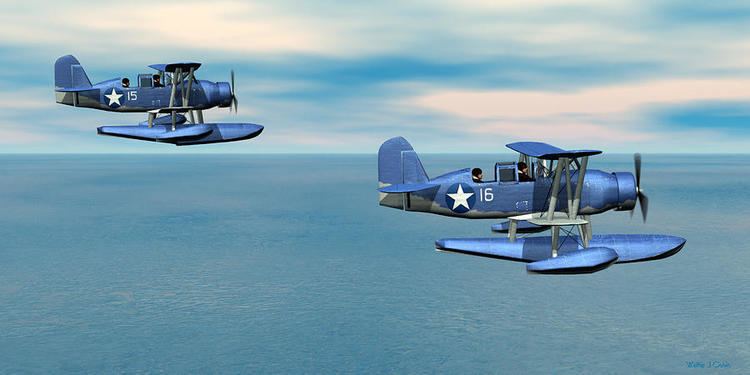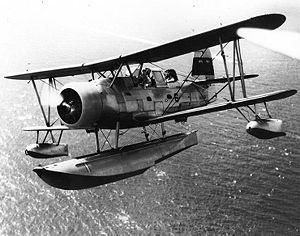Top speed 266 km/h Length 9.58 m | Wingspan 11 m Introduced 12 November 1935 Number of seats 2 | |
 | ||
Engine type Pratt & Whitney R-1340 Wasp | ||
The Curtiss SOC Seagull was an American single-engined scout observation biplane aircraft, designed by Alexander Solla of the Curtiss-Wright Corporation for the United States Navy. The aircraft served on battleships and cruisers in a seaplane configuration, being launched by catapult and recovered from a sea landing. The wings folded back against the fuselage for storage aboard ship. When based ashore or on carriers the single float was replaced by fixed wheeled landing gear.
Contents
- Curtiss soc seagull aircraft lands on surface of water in the south west pacific hd stock footage
- Design and development
- Operational history
- Variants
- Operators
- Specifications SOC 1 floatplane
- References

Curtiss delivered 258 SOC aircraft, in versions SOC-1 through SOC-4, beginning in 1935. The SOC-3 design was the basis of the Naval Aircraft Factory SON-1 variant, of which the NAF delivered 64 aircraft from 1940.

Curtiss soc seagull aircraft lands on surface of water in the south west pacific hd stock footage
Design and development

The SOC was ordered for production by the United States Navy in 1933 and first entered service in 1935. The first order was for 135 SOC-1 models, which was followed by 40 SOC-2 models for landing operations and 83 SOC-3s. A variant of the SOC-3 was built by the Naval Aircraft Factory and was known as the SON-1.
Operational history

The first ship the SOC was assigned to was the light cruiser USS Marblehead in November 1935; by the end of the decade, the SOC had replaced its predecessor throughout the fleet. Production came to an end in 1938. By 1941, most battleships had transitioned to the Vought OS2U Kingfisher and cruisers were expected to replace their aging SOCs with the third generation SO3C Seamew. The SO3C, however, suffered from a weak engine and plans to adopt it as a replacement were scrapped. The SOC, despite belonging to an earlier generation, went on to execute its missions of gunfire observation and limited range scouting missions.
Through the first six months of naval service, the SOC was known as the XO3C-1, The designation was changed to SOC when it was decided to merge its scouting and observation roles. The SOC was not called the Seagull until 1941, when the U.S. Navy began the wholesale adoption of popular names for aircraft in addition to their alpha-numeric designations. The name 'Seagull' had earlier been given to two civil Curtiss aircraft, a Curtiss Model 18 and a Model 25, both converted Curtiss MF flying boats.
When operating as a seaplane, returning SOCs would land on the relatively smooth ocean surface created on the sheltered side of the vessel as it made a wide turn, after which the aircraft would be winched back onto the deck.
When the SOC was replaced by the OS2U Kingfisher, most remaining airframes were converted into trainers; they remained in use until 1945. With the failure of the Curtiss SO3C Seamew, many SOCs in second line service were returned to frontline units starting in late 1943. They saw service aboard warships in the combat zone for the rest of World War II. This is one of the few instances in aviation history of an older aircraft type that was retired or sent to second line service, replacing the new aircraft type that was supposed to replace it.
Variants
Operators
Specifications (SOC-1 floatplane)
Data from War Planes of the Second World War, Volume Six: Floatplanes
General characteristics
Performance
Armament
